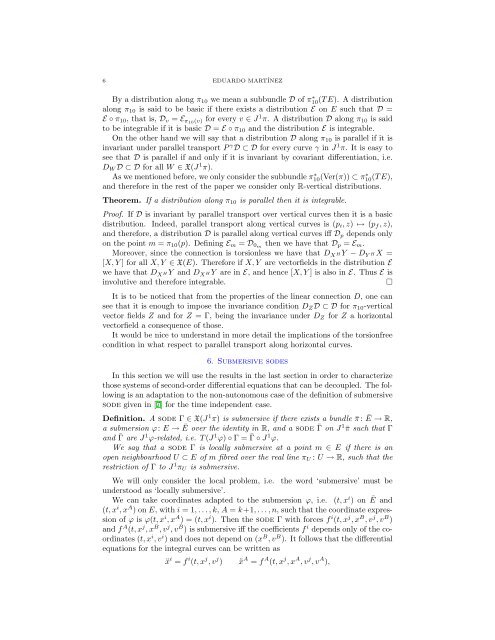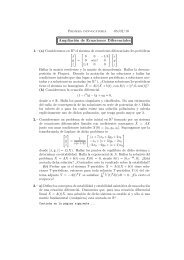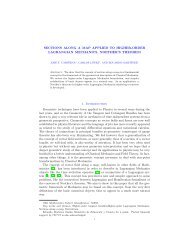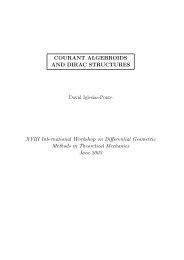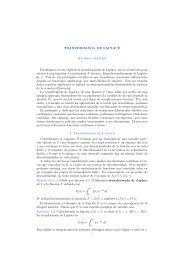PARALLEL TRANSPORT AND DECOUPLING 1. Introduction One of ...
PARALLEL TRANSPORT AND DECOUPLING 1. Introduction One of ...
PARALLEL TRANSPORT AND DECOUPLING 1. Introduction One of ...
You also want an ePaper? Increase the reach of your titles
YUMPU automatically turns print PDFs into web optimized ePapers that Google loves.
6 EDUARDO MARTÍNEZBy a distribution along π 10 we mean a subbundle D <strong>of</strong> π ∗ 10(T E). A distributionalong π 10 is said to be basic if there exists a distribution E on E such that D =E ◦ π 10 , that is, D v = E π10(v) for every v ∈ J 1 π. A distribution D along π 10 is saidto be integrable if it is basic D = E ◦ π 10 and the distribution E is integrable.On the other hand we will say that a distribution D along π 10 is parallel if it isinvariant under parallel transport P γ D ⊂ D for every curve γ in J 1 π. It is easy tosee that D is parallel if and only if it is invariant by covariant differentiation, i.e.D W D ⊂ D for all W ∈ X(J 1 π).As we mentioned before, we only consider the subbundle π ∗ 10(Ver(π)) ⊂ π ∗ 10(T E),and therefore in the rest <strong>of</strong> the paper we consider only R-vertical distributions.Theorem. If a distribution along π 10 is parallel then it is integrable.Pro<strong>of</strong>. If D is invariant by parallel transport over vertical curves then it is a basicdistribution. Indeed, parallel transport along vertical curves is (p i , z) ↦→ (p f , z),and therefore, a distribution D is parallel along vertical curves iff D p depends onlyon the point m = π 10 (p). Defining E m = D 0m then we have that D p = E m .Moreover, since the connection is torsionless we have that D X H Y − D Y H X =[X, Y ] for all X, Y ∈ X(E). Therefore if X, Y are vectorfields in the distribution Ewe have that D X H Y and D X H Y are in E, and hence [X, Y ] is also in E. Thus E isinvolutive and therefore integrable.□It is to be noticed that from the properties <strong>of</strong> the linear connection D, one cansee that it is enough to impose the invariance condition D Z D ⊂ D for π 10 -verticalvector fields Z and for Z = Γ, being the invariance under D Z for Z a horizontalvectorfield a consequence <strong>of</strong> those.It would be nice to understand in more detail the implications <strong>of</strong> the torsionfreecondition in what respect to parallel transport along horizontal curves.6. Submersive sodesIn this section we will use the results in the last section in order to characterizethose systems <strong>of</strong> second-order differential equations that can be decoupled. The followingis an adaptation to the non-autonomous case <strong>of</strong> the definition <strong>of</strong> submersivesode given in [7] for the time independent case.Definition. A sode Γ ∈ X(J 1 π) is submersive if there exists a bundle ¯π : Ē → R,a submersion ϕ: E → Ē over the identity in R, and a sode ¯Γ on J 1¯π such that Γand ¯Γ are J 1 ϕ-related, i.e. T (J 1 ϕ) ◦ Γ = ¯Γ ◦ J 1 ϕ.We say that a sode Γ is locally submersive at a point m ∈ E if there is anopen neighbourhood U ⊂ E <strong>of</strong> m fibred over the real line π U : U → R, such that therestriction <strong>of</strong> Γ to J 1 π U is submersive.We will only consider the local problem, i.e. the word ‘submersive’ must beunderstood as ‘locally submersive’.We can take coordinates adapted to the submersion ϕ, i.e. (t, x i ) on Ē and(t, x i , x A ) on E, with i = 1, . . . , k, A = k+1, . . . , n, such that the coordinate expression<strong>of</strong> ϕ is ϕ(t, x i , x A ) = (t, x i ). Then the sode Γ with forces f i (t, x j , x B , v j , v B )and f A (t, x j , x B , v j , v B ) is submersive iff the coefficients f i depends only <strong>of</strong> the coordinates(t, x i , v i ) and does not depend on (x B , v B ). It follows that the differentialequations for the integral curves can be written asẍ i = f i (t, x j , v j ) ẍ A = f A (t, x j , x A , v j , v A ),


